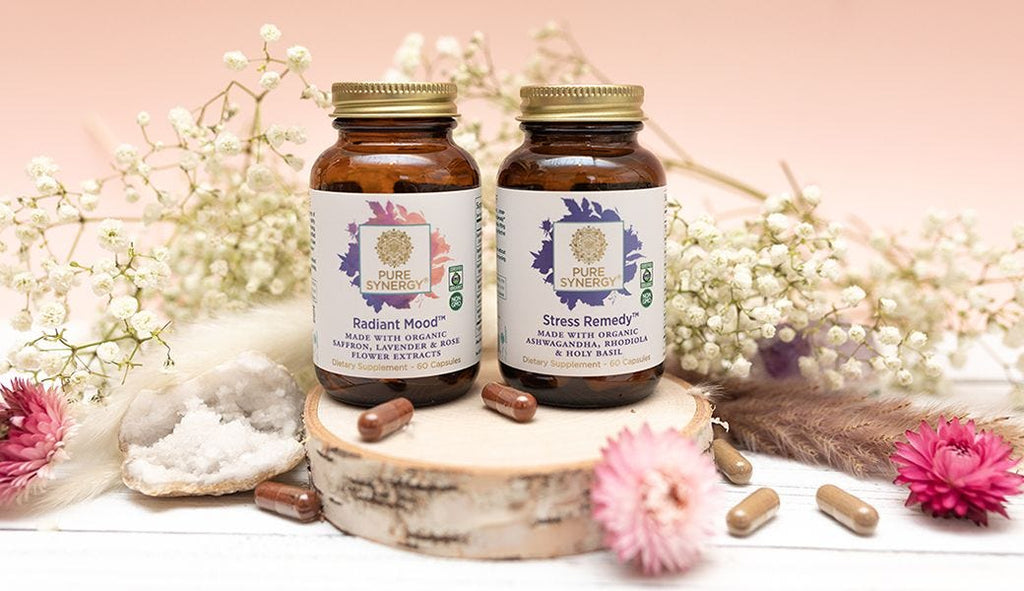Finding Symmetry on the Spectrum of Stress
Finding Symmetry on the Spectrum of Stress
At its simplest, worry is woven into humanity. As relational, conscientious beings, to worry is to care. Parents worry about their children’s health, safety, and success; friends worry about each other’s happiness; citizens worry about a just, sustainable society. In some sense, worry contributes to human purpose and satisfaction as we identify problems, find solutions, and achieve progress.
Theoretically, physical and psychological stress have similar potential. We are equipped with biological responses that not only enable us to survive, they ultimately enhance our overall self-confidence. On the other side of a challenge, we feel more capable, resourceful, and better equipped to encounter it again. Without perceiving it, our brains are shaped by the decisions and lessons that a stressful situation can bring.
Even when they don’t feel as fruitful, worry and stress should still be temporary and manageable overall, ebbing quieter with day’s end. Ideally, our body’s equilibrium returns, resolve is reset by deep rest, healthy behaviors refill our tanks, and family and friends encourage our spirits. We regain our sense of control and stability as our bodies recenter.
But that’s not everyone’s story; maybe not for a lot of us. In our modern world, there is much to worry about. The gift of greater connectedness is not without its sacrifices. Our immediate attention is demanded at every turn, and compassion requires a concerned response to the day’s news. While our bodies are built with mechanisms to handle sporadic alarms, incessant triggers are a unique feature of today, broadly expanding the scope of stress and the forms it can take.
The Stress Spectrum
Acute Stress
When we talk about stress nowadays, we’re not typically thinking of a normal, healthy response to acute threats, even though it stems from the same biological process. Anything that startles, spooks, or threatens initiates a powerful protocol from the brain to the rest of the body to be on the alert. An instantaneous signal along our hypothalamic-pituitary-adrenal (HPA) axis lets loose cortisol and adrenaline so that all systems are go.


Almost imperceptibly, our heart rate, breathing, and muscle tone increase. Blood flow accelerates, carrying energizing nutrients and immune reserves ready to defend and repair. Any non-urgent functions are put aside, like digestion, building, and healing. Rational thinking is less important than unmediated instinct and reflexive reactions. While this self-preservation mode means well, in this state we’re irritable, anxious, unfocused, and unproductive.
It's in this miraculous, rapid coordination of events, that our bodies are best equipped to face a threat, whether or not it’s legitimate. And that’s where our constantly worrisome world comes in. What happens when the “threat” doesn’t go away? This type of toxic stress is the nebulous foe that we face today. The temporary imbalances for quick action are a problem when they persist.
Problematic Stress
When ongoing, excessive HPA activation and restricted functions are a recipe for biological confusion. When processes that are meant to be limited don’t ramp down as expected, cells that are waiting for rest from a red light stop watching for one. Sometimes these desensitized cells and tissues let their guard down for good and just run on autopilot. In the case of our adrenal glands, that means cortisol and other stimulating chemicals stay in circulation.
With unending stress comes negative reactions that look a lot like our acute stress signs taken to the next level. With free reign, cortisol zaps our energy, disrupts our sleep patterns, and distorts our moods. In the brain, cortisol’s warnings affect the harmony of neurotransmitters responsible for our sense of motivation and well-being. And a prioritization towards our emotional, reactive state sidelines our ability to think and deliberate.
Beyond Stress
Sometimes, the cycle of recurring stress can move from fatigue and mood swings to a persistent state of unsettledness. Even when our circumstances are favorable and low-pressure, we can’t shake feelings of anxiousness and unease. In fact, the impetus for our angst might be long in the past or completely unknown.
If cortisol is never curbed, the neurotransmitters in the brain that are responsible for our well-being and motivation, like serotonin, GABA, and dopamine remain off-kilter. Our neural pathways are locked in a false feedback loop of discouragement and apathy. At this extreme end of the stress spectrum, mood swings never have an upstroke. Despite a nutritious diet, exercise, and other healthy stress management techniques, our daily outlook might be darker than for most.
Your Stress Mosaic
While it can be helpful to categorize stress as “normal”, “prolonged”, “good”, or “toxic”, our stress experiences are as multifactorial as we are. Our genetics, health status, culture, past, and environment all determine what stressors we might encounter, where they come from, and how we react to them.
The luckiest among us roll with the punches and bounce back quickly from every stress battle. But more of us depend on grit and determination, sometimes grinning through our days with clenched teeth. We’re “fine", keeping up with our obligations but running on fumes and knowing our overall health is quietly affected. And then there are those in a more precarious state - when even a stress reset can’t lift our moods.
So, the many faces of stress mean there is hardly a one-size-fits-all solution. If you’re a demi-god with a steel spine and Kevlar skin, thanks for reading this far! But we’re here to talk to our friends that are ready to restore balance, find clarity, and take back their days with help from earth’s ingenuity.
For the Stress-Weary
For a lot of us, the key to managing stress is providing strengthening support for our HPA axis. If we’re blurred and burned out by the everyday, the best approach is to boost our body’s ability to handle stress as intended – bouncing back like a fresh rubber band rather than one that’s lost its snap. Resilience is our goal, including the energy, focus, and poise to persevere.
This was our intention with Stress Remedy™. Merging herbal wisdom and stunning scientific insight, we sought to learn from some of the toughest characters we know: plants. The fearless foliage that beautifies our planet offers fascinating know-how on beating the odds with fortitude and grace. Their secret? Adaptation.
We have adaptive mechanisms too, but some plants are nature’s pros at sensing and withstanding threats. Through physical and chemical means, plants safeguard their resources and equip their defenses in rapid fashion when stressors come along. Scientists admire this group of plants so much that they call them “adaptogens”, since it turns out these savvy herbs can help our bodies gen-erate a similar adapt-ive response.
Adaptogenic A-listers like Ashwagandha, Rhodiola, and Eleuthero help teach our bodies Resilience 101. Their stealthy playbook reveals not only how they can help spark our natural energy and foster a more balanced immune response, but the treasure they hold for enduring challenges with restraint and stamina. Adaptogens haven’t yet divulged all of their wizardry, but research continues to back these ingredients for specifically counteracting cortisol’s overstimulation of our HPA axis.
Rounding out our Stress Remedy sucker-punch is a suite of brain-soothing, antioxidant herbs that help clear away the stress-induced fog and distraction so our thoughts are positive and constructive. Even if life seems like a rollercoaster, our moods don’t have to take the ride, making demanding days feel more manageable and less overwhelming.
When You Need Deeper Calm
Whether our mental disquiet is rooted in toxic stress or more tightly interwoven into the fabric of our history and biochemistry, more of us than ever are looking for support in overcoming a persistently pessimistic mindset. Some chew on anxious thoughts; others find themselves heavy-laden with dissatisfaction. Stress burnout may or may not have been the culprit, but for the most part, an unceasing restlessness or apathy are the products of a disproportionate soup of brain neurotransmitters.
In the realm of mental well-being, serotonin, dopamine, and GABA lead our neurochemical cast. Serotonin and GABA are always on the side of harmony, rest, and homeostasis. Although dopamine is excitatory, it has a critical role in driving our self-esteem: we need just enough dopamine to seek after happiness and satisfaction. Critically, a counterbalance between these neural hormones facilitates a brain at rest.
One substantive result of our negative thought patterns and mental reactions to stress is brain tissue that is assaulted by oxidative stress. When we think of the immune system, we may not immediately think of our brain, but as arguably our most precious resource, it contains a dedicated immune force. Like physical stress, this defense line fights for balance in our state of emotional distress. But amidst a sea of immune chemicals, maintaining a positive mood is low on the list of our brain’s priorities.
It's clear that lasting support for restoring and sustaining a positive mood requires a delicate yet purposeful hand of realignment. And what better embodies this spirit than organic and wild-crafted botanicals? Our research into the perfect blend to calm, rebalance, and reinspire took us to a timeless garden of herbal wisdom. Combining pure botanical extracts that promote relaxation, rest, and stability in Radiant Mood® was a labor of love.
Several floral ingredients in Radiant Mood, like Albizia, Saffron, and Magnolia directly promote the persistence of our calming neurotransmitters, serotonin, and GABA. Others, like Gardenia, encourage placid but steady blood flow to enrich our brain cells. Lavender was non-negotiable for supporting deep, refreshing rest. And finally, we kept oxidative stress in our sights by including powerful polyphenols that help preserve our newly balanced mood.
Always Synergy
It’s not always possible to parse out what’s behind our stress or our mood states, and impossible to predict what might sap our HPA or scramble our neurotransmitters on any given day. But the beauty of Stress Remedy and Radiant Mood is that these formulas are both on board to help you pursue peace and joy.
We’ve designed these products with synergy in mind for the brightest of days; they can be taken separately or together to help you regain your balance and support a sustained uplift to your spirit. Our intention with these complementary products is to meet your mood where it’s at, and give you customized calm for fluctuating days and seasons.


Our stressors might shift and our moods might morph, but that doesn’t mean we can’t stay in control. Instead of conceding to perpetual stress-induced fatigue or masking our struggles, let this be an empowering call for all of us to take the first step away from the status quo. Let’s find new inspiration from nature’s resilience and learn from the plants that teach, train, and tend our brains and our bodies for bliss.










